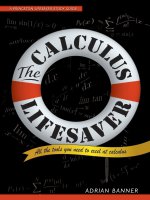The Calculus Lifesaver: All the Tools You Need to Excel at Calculus - Adrian Banner
Bạn đang xem bản rút gọn của tài liệu. Xem và tải ngay bản đầy đủ của tài liệu tại đây (24.09 MB, 753 trang )
T h e C a l c u l u s L i f e s ave r
PRINCETON UNIVERSITY PRESS
Princeton and Oxford
Copyright
c
2007 by Princeton University Press
Published by Princeton University Press, 41 William Street, Princeton,
New Jersey 08540
in the United Kingdom: Princeton University Press, 3 Market Place, Woodstock,
Oxfordshire OX20 1SY
All Rights Reserved
Library of Congress Control Number: 2006939343
ISBN-13: 978-0-691-13153-5 (cloth)
ISBN-10: 0-691-13153-8 (cloth)
ISBN-13: 978-0-691-13088-0 (paper)
ISBN-10: 0-691-13088-4 (paper)
British Library Cataloging-in-Publication Data is available
This book has been composed in Times Roman
The publisher would like to acknowledge the author of this volume for
providing the camera-ready copy from which this book was printed
Printed on acid-free paper. ∞
pup.princeton.edu
Printed in the United States of America
1 3 5 7 9 10 8 6 4 2
To YarryC o n t e n t s
Welcome xviii
How to Use This Book to Study for an Exam xix
Two all-purpose study tips xx
Key sections for exam review (by topic) xx
Acknowledgments xxiii
1 Functions, Graphs, and Lines 1
1.1 Functions 1
1.1.1 Interval notation 3
1.1.2 Finding the domain 4
1.1.3 Finding the range using the graph 5
1.1.4 The vertical line test 6
1.2 Inverse Functions 7
1.2.1 The horizontal line test 8
1.2.2 Finding the inverse 9
1.2.3 Restricting the domain 9
1.2.4 Inverses of inverse functions 11
1.3 Composition of Functions 11
1.4 Odd and Even Functions 14
1.5 Graphs of Linear Functions 17
1.6 Common Functions and Graphs 19
2 Review of Trigonometry 25
2.1 The Basics 25
2.2 Extending the Domain of Trig Functions 28
2.2.1 The ASTC method 31
2.2.2 Trig functions outside [0, 2π] 33
2.3 The Graphs of Trig Functions 35
2.4 Trig Identities 39
viii • Contents
3 Introduction to Limits 41
3.1 Limits: The Basic Idea 41
3.2 Left-Hand and Right-Hand Limits 43
3.3 When the Limit Does Not Exist 45
3.4 Limits at ∞ and −∞ 47
3.4.1 Large numbers and small numbers 48
3.5 Two Common Misconceptions about Asymptotes 50
3.6 The Sandwich Principle 51
3.7 Summary of Basic Types of Limits 54
4 How to Solve Limit Problems Involving Polynomials 57
4.1 Limits Involving Rational Functions as x → a 57
4.2 Limits Involving Square Roots as x → a 61
4.3 Limits Involving Rational Functions as x → ∞ 61
4.3.1 Method and examples 64
4.4 Limits Involving Poly-type Functions as x → ∞ 66
4.5 Limits Involving Rational Functions as x → −∞ 70
4.6 Limits Involving Absolute Values 72
5 Continuity and Differentiability 75
5.1 Continuity 75
5.1.1 Continuity at a point 76
5.1.2 Continuity on an interval 77
5.1.3 Examples of continuous functions 77
5.1.4 The Intermediate Value Theorem 80
5.1.5 A harder IVT example 82
5.1.6 Maxima and minima of continuous functions 82
5.2 Differentiability 84
5.2.1 Average speed 84
5.2.2 Displacement and velocity 85
5.2.3 Instantaneous velocity 86
5.2.4 The graphical interpretation of velocity 87
5.2.5 Tangent lines 88
5.2.6 The derivative function 90
5.2.7 The derivative as a limiting ratio 91
5.2.8 The derivative of linear functions 93
5.2.9 Second and higher-order derivatives 94
5.2.10 When the derivative does not exist 94
5.2.11 Differentiability and continuity 96
6 How to Solve Differentiation Problems 99
6.1 Finding Derivatives Using the Definition 99
6.2 Finding Derivatives (the Nice Way) 102
6.2.1 Constant multiples of functions 103
Contents • ix
6.2.2 Sums and differences of functions 103
6.2.3 Products of functions via the product rule 104
6.2.4 Quotients of functions via the quotient rule 105
6.2.5 Composition of functions via the chain rule 107
6.2.6 A nasty example 109
6.2.7 Justification of the product rule and the chain rule 111
6.3 Finding the Equation of a Tangent Line 114
6.4 Velocity and Acceleration 114
6.4.1 Constant negative acceleration 115
6.5 Limits Which Are Derivatives in Disguise 117
6.6 Derivatives of Piecewise-Defined Functions 119
6.7 Sketching Derivative Graphs Directly 123
7 Trig Limits and Derivatives 127
7.1 Limits Involving Trig Functions 127
7.1.1 The small case 128
7.1.2 Solving problems—the small case 129
7.1.3 The large case 134
7.1.4 The “other” case 137
7.1.5 Proof of an important limit 137
7.2 Derivatives Involving Trig Functions 141
7.2.1 Examples of differentiating trig functions 143
7.2.2 Simple harmonic motion 145
7.2.3 A curious function 146
8 Implicit Differentiation and Related Rates 149
8.1 Implicit Differentiation 149
8.1.1 Techniques and examples 150
8.1.2 Finding the second derivative implicitly 154
8.2 Related Rates 156
8.2.1 A simple example 157
8.2.2 A slightly harder example 159
8.2.3 A much harder example 160
8.2.4 A really hard example 162
9 Exponentials and Logarithms 167
9.1 The Basics 167
9.1.1 Review of exponentials 167
9.1.2 Review of logarithms 168
9.1.3 Logarithms, exponentials, and inverses 169
9.1.4 Log rules 170
9.2 Definition of e 173
9.2.1 A question about compound interest 173
9.2.2 The answer to our question 173
9.2.3 More about e and logs 175
9.3 Differentiation of Logs and Exponentials 177
x • Contents
9.3.1 Examples of differentiating exponentials and logs 179
9.4 How to Solve Limit Problems Involving Exponentials or Logs 180
9.4.1 Limits involving the definition of e 181
9.4.2 Behavior of exponentials near 0 182
9.4.3 Behavior of logarithms near 1 183
9.4.4 Behavior of exponentials near ∞ or −∞ 184
9.4.5 Behavior of logs near ∞ 187
9.4.6 Behavior of logs near 0 188
9.5 Logarithmic Differentiation 189
9.5.1 The derivative of x
a
192
9.6 Exponential Growth and Decay 193
9.6.1 Exponential growth 194
9.6.2 Exponential decay 195
9.7 Hyperbolic Functions 198
10 Inverse Functions and Inverse Trig Functions 201
10.1 The Derivative and Inverse Functions 201
10.1.1 Using the derivative to show that an inverse exists 201
10.1.2 Derivatives and inverse functions: what can go wrong 203
10.1.3 Finding the derivative of an inverse function 204
10.1.4 A big example 206
10.2 Inverse Trig Functions 208
10.2.1 Inverse sine 208
10.2.2 Inverse cosine 211
10.2.3 Inverse tangent 213
10.2.4 Inverse secant 216
10.2.5 Inverse cosecant and inverse cotangent 217
10.2.6 Computing inverse trig functions 218
10.3 Inverse Hyperbolic Functions 220
10.3.1 The rest of the inverse hyperbolic functions 222
11 The Derivative and Graphs 225
11.1 Extrema of Functions 225
11.1.1 Global and local extrema 225
11.1.2 The Extreme Value Theorem 227
11.1.3 How to find global maxima and minima 228
11.2 Rolle’s Theorem 230
11.3 The Mean Value Theorem 233
11.3.1 Consequences of the Mean Value Theorem 235
11.4 The Second Derivative and Graphs 237
11.4.1 More about points of inflection 238
11.5 Classifying Points Where the Derivative Vanishes 239
11.5.1 Using the first derivative 240
11.5.2 Using the second derivative 242
Contents • xi
12 Sketching Graphs 245
12.1 How to Construct a Table of Signs 245
12.1.1 Making a table of signs for the derivative 247
12.1.2 Making a table of signs for the second derivative 248
12.2 The Big Method 250
12.3 Examples 252
12.3.1 An example without using derivatives 252
12.3.2 The full method: example 1 254
12.3.3 The full method: example 2 256
12.3.4 The full method: example 3 259
12.3.5 The full method: example 4 262
13 Optimization and Linearization 267
13.1 Optimization 267
13.1.1 An easy optimization example 267
13.1.2 Optimization problems: the general method 269
13.1.3 An optimization example 269
13.1.4 Another optimization example 271
13.1.5 Using implicit differentiation in optimization 274
13.1.6 A difficult optimization example 275
13.2 Linearization 278
13.2.1 Linearization in general 279
13.2.2 The differential 281
13.2.3 Linearization summary and examples 283
13.2.4 The error in our approximation 285
13.3 Newton’s Method 287
14 L’Hˆopital’s Rule and Overview of Limits 293
14.1 L’Hˆopital’s Rule 293
14.1.1 Type A: 0/0 case 294
14.1.2 Type A: ±∞/±∞ case 296
14.1.3 Type B1 (∞ − ∞) 298
14.1.4 Type B2 (0 ×±∞) 299
14.1.5 Type C (1
±∞
, 0
0
, or ∞
0
) 301
14.1.6 Summary of l’Hˆopital’s Rule types 302
14.2 Overview of Limits 303
15 Introduction to Integration 307
15.1 Sigma Notation 307
15.1.1 A nice sum 310
15.1.2 Telescoping series 311
15.2 Displacement and Area 314
15.2.1 Three simple cases 314
15.2.2 A more general journey 317
15.2.3 Signed area 319
15.2.4 Continuous velocity 320
xii • Contents
15.2.5 Two special approximations 323
16 Definite Integrals 325
16.1 The Basic Idea 325
16.1.1 Some easy examples 327
16.2 Definition of the Definite Integral 330
16.2.1 An example of using the definition 331
16.3 Properties of Definite Integrals 334
16.4 Finding Areas 339
16.4.1 Finding the unsigned area 339
16.4.2 Finding the area between two curves 342
16.4.3 Finding the area between a curve and the y-axis 344
16.5 Estimating Integrals 346
16.5.1 A simple type of estimation 347
16.6 Averages and the Mean Value Theorem for Integrals 350
16.6.1 The Mean Value Theorem for integrals 351
16.7 A Nonintegrable Function 353
17 The Fundamental Theorems of Calculus 355
17.1 Functions Based on Integrals of Other Functions 355
17.2 The First Fundamental Theorem 358
17.2.1 Introduction to antiderivatives 361
17.3 The Second Fundamental Theorem 362
17.4 Indefinite Integrals 364
17.5 How to Solve Problems: The First Fundamental Theorem 366
17.5.1 Variation 1: variable left-hand limit of integration 367
17.5.2 Variation 2: one tricky limit of integration 367
17.5.3 Variation 3: two tricky limits of integration 369
17.5.4 Variation 4: limit is a derivative in disguise 370
17.6 How to Solve Problems: The Second Fundamental Theorem 371
17.6.1 Finding indefinite integrals 371
17.6.2 Finding definite integrals 374
17.6.3 Unsigned areas and absolute values 376
17.7 A Technical Point 380
17.8 Proof of the First Fundamental Theorem 381
18 Techniques of Integration, Part One 383
18.1 Substitution 383
18.1.1 Substitution and definite integrals 386
18.1.2 How to decide what to substitute 389
18.1.3 Theoretical justification of the substitution method 392
18.2 Integration by Parts 393
18.2.1 Some variations 394
18.3 Partial Fractions 397
Contents • xiii
18.3.1 The algebra of partial fractions 398
18.3.2 Integrating the pieces 401
18.3.3 The method and a big example 404
19 Techniques of Integration, Part Two 409
19.1 Integrals Involving Trig Identities 409
19.2 Integrals Involving Powers of Trig Functions 413
19.2.1 Powers of sin and/or cos 413
19.2.2 Powers of tan 415
19.2.3 Powers of sec 416
19.2.4 Powers of cot 418
19.2.5 Powers of csc 418
19.2.6 Reduction formulas 419
19.3 Integrals Involving Trig Substitutions 421
19.3.1 Type 1:
a
2
− x
2
421
19.3.2 Type 2:
x
2
+ a
2
423
19.3.3 Type 3:
x
2
− a
2
424
19.3.4 Completing the square and trig substitutions 426
19.3.5 Summary of trig substitutions 426
19.3.6 Technicalities of square roots and trig substitutions 427
19.4 Overview of Techniques of Integration 429
20 Improper Integrals: Basic Concepts 431
20.1 Convergence and Divergence 431
20.1.1 Some examples of improper integrals 433
20.1.2 Other blow-up points 435
20.2 Integrals over Unbounded Regions 437
20.3 The Comparison Test (Theory) 439
20.4 The Limit Comparison Test (Theory) 441
20.4.1 Functions asymptotic to each other 441
20.4.2 The statement of the test 443
20.5 The p-test (Theory) 444
20.6 The Absolute Convergence Test 447
21 Improper Integrals: How to Solve Problems 451
21.1 How to Get Started 451
21.1.1 Splitting up the integral 452
21.1.2 How to deal with negative function values 453
21.2 Summary of Integral Tests 454
21.3 Behavior of Common Functions near ∞ and −∞ 456
21.3.1 Polynomials and poly-type functions near ∞ and −∞ 456
21.3.2 Trig functions near ∞ and −∞ 459
21.3.3 Exponentials near ∞ and −∞ 461
21.3.4 Logarithms near ∞ 465
21.4 Behavior of Common Functions near 0 469
xiv • Contents
21.4.1 Polynomials and poly-type functions near 0 469
21.4.2 Trig functions near 0 470
21.4.3 Exponentials near 0 472
21.4.4 Logarithms near 0 473
21.4.5 The behavior of more general functions near 0 474
21.5 How to Deal with Problem Spots Not at 0 or ∞ 475
22 Sequences and Series: Basic Concepts 477
22.1 Convergence and Divergence of Sequences 477
22.1.1 The connection between sequences and functions 478
22.1.2 Two important sequences 480
22.2 Convergence and Divergence of Series 481
22.2.1 Geometric series (theory) 484
22.3 The nth Term Test (Theory) 486
22.4 Properties of Both Infinite Series and Improper Integrals 487
22.4.1 The comparison test (theory) 487
22.4.2 The limit comparison test (theory) 488
22.4.3 The p-test (theory) 489
22.4.4 The absolute convergence test 490
22.5 New Tests for Series 491
22.5.1 The ratio test (theory) 492
22.5.2 The root test (theory) 493
22.5.3 The integral test (theory) 494
22.5.4 The alternating series test (theory) 497
23 How to Solve Series Problems 501
23.1 How to Evaluate Geometric Series 502
23.2 How to Use the nth Term Test 503
23.3 How to Use the Ratio Test 504
23.4 How to Use the Root Test 508
23.5 How to Use the Integral Test 509
23.6 Comparison Test, Limit Comparison Test, and p-test 510
23.7 How to Deal with Series with Negative Terms 515
24 Taylor Polynomials, Taylor Series, and Power Series 519
24.1 Approximations and Taylor Polynomials 519
24.1.1 Linearization revisited 520
24.1.2 Quadratic approximations 521
24.1.3 Higher-degree approximations 522
24.1.4 Taylor’s Theorem 523
24.2 Power Series and Taylor Series 526
24.2.1 Power series in general 527
24.2.2 Taylor series and Maclaurin series 529
24.2.3 Convergence of Taylor series 530
24.3 A Useful Limit 534
Contents • xv
25 How to Solve Estimation Problems 535
25.1 Summary of Taylor Polynomials and Series 535
25.2 Finding Taylor Polynomials and Series 537
25.3 Estimation Problems Using the Error Term 540
25.3.1 First example 541
25.3.2 Second example 543
25.3.3 Third example 544
25.3.4 Fourth example 546
25.3.5 Fifth example 547
25.3.6 General techniques for estimating the error term 548
25.4 Another Technique for Estimating the Error 548
26 Taylor and Power Series: How to Solve Problems 551
26.1 Convergence of Power Series 551
26.1.1 Radius of convergence 551
26.1.2 How to find the radius and region of convergence 554
26.2 Getting New Taylor Series from Old Ones 558
26.2.1 Substitution and Taylor series 560
26.2.2 Differentiating Taylor series 562
26.2.3 Integrating Taylor series 563
26.2.4 Adding and subtracting Taylor series 565
26.2.5 Multiplying Taylor series 566
26.2.6 Dividing Taylor series 567
26.3 Using Power and Taylor Series to Find Derivatives 568
26.4 Using Maclaurin Series to Find Limits 570
27 Parametric Equations and Polar Coordinates 575
27.1 Parametric Equations 575
27.1.1 Derivatives of parametric equations 578
27.2 Polar Coordinates 581
27.2.1 Converting to and from polar coordinates 582
27.2.2 Sketching curves in polar coordinates 585
27.2.3 Finding tangents to polar curves 590
27.2.4 Finding areas enclosed by polar curves 591
28 Complex Numbers 595
28.1 The Basics 595
28.1.1 Complex exponentials 598
28.2 The Complex Plane 599
28.2.1 Converting to and from polar form 601
28.3 Taking Large Powers of Complex Numbers 603
28.4 Solving z
n
= w 604
28.4.1 Some variations 608
28.5 Solving e
z
= w 610
28.6 Some Trigonometric Series 612
xvi • Contents
28.7 Euler’s Identity and Power Series 615
29 Volumes, Arc Lengths, and Surface Areas 617
29.1 Volumes of Solids of Revolution 617
29.1.1 The disc method 619
29.1.2 The shell method 620
29.1.3 Summary . . . and variations 622
29.1.4 Variation 1: regions between a curve and the y-axis 623
29.1.5 Variation 2: regions between two curves 625
29.1.6 Variation 3: axes parallel to the coordinate axes 628
29.2 Volumes of General Solids 631
29.3 Arc Lengths 637
29.3.1 Parametrization and speed 639
29.4 Surface Areas of Solids of Revolution 640
30 Differential Equations 645
30.1 Introduction to Differential Equations 645
30.2 Separable First-order Differential Equations 646
30.3 First-order Linear Equations 648
30.3.1 Why the integrating factor works 652
30.4 Constant-coefficient Differential Equations 653
30.4.1 Solving first-order homogeneous equations 654
30.4.2 Solving second-order homogeneous equations 654
30.4.3 Why the characteristic quadratic method works 655
30.4.4 Nonhomogeneous equations and particular solutions 656
30.4.5 Finding a particular solution 658
30.4.6 Examples of finding particular solutions 660
30.4.7 Resolving conflicts between y
P
and y
H
662
30.4.8 Initial value problems (constant-coefficient linear) 663
30.5 Modeling Using Differential Equations 665
Appendix A Limits and Proofs 669
A.1 Formal Definition of a Limit 669
A.1.1 A little game 670
A.1.2 The actual definition 672
A.1.3 Examples of using the definition 672
A.2 Making New Limits from Old Ones 674
A.2.1 Sums and differences of limits—proofs 674
A.2.2 Products of limits—proof 675
A.2.3 Quotients of limits—proof 676
A.2.4 The sandwich principle—proof 678
A.3 Other Varieties of Limits 678
A.3.1 Infinite limits 679
A.3.2 Left-hand and right-hand limits 680
A.3.3 Limits at ∞ and −∞ 680
Contents • xvii
A.3.4 Two examples involving trig 682
A.4 Continuity and Limits 684
A.4.1 Composition of continuous functions 684
A.4.2 Proof of the Intermediate Value Theorem 686
A.4.3 Proof of the Max-Min Theorem 687
A.5 Exponentials and Logarithms Revisited 689
A.6 Differentiation and Limits 691
A.6.1 Constant multiples of functions 691
A.6.2 Sums and differences of functions 691
A.6.3 Proof of the product rule 692
A.6.4 Proof of the quotient rule 693
A.6.5 Proof of the chain rule 693
A.6.6 Proof of the Extreme Value Theorem 694
A.6.7 Proof of Rolle’s Theorem 695
A.6.8 Proof of the Mean Value Theorem 695
A.6.9 The error in linearization 696
A.6.10 Derivatives of piecewise-defined functions 697
A.6.11 Proof of l’Hˆopital’s Rule 698
A.7 Proof of the Taylor Approximation Theorem 700
Appendix B Estimating Integrals 703
B.1 Estimating Integrals Using Strips 703
B.1.1 Evenly spaced partitions 705
B.2 The Trapezoidal Rule 706
B.3 Simpson’s Rule 709
B.3.1 Proof of Simpson’s rule 710
B.4 The Error in Our Approximations 711
B.4.1 Examples of estimating the error 712
B.4.2 Proof of an error term inequality 714
List of Symbols 717
Index 719
W e l c o m e !
This book is designed to help you learn the major concepts of single-variable
calculus, while also concentrating on problem-solving techniques. Whether
this is your first exposure to calculus, or you are studying for a test, or you’ve
already taken calculus and want to refresh your memory, I hope that this book
will be a useful resource.
The inspiration for this book came from my students at Princeton Univer-
sity. Over the past few years, they have found early drafts to be helpful as a
study guide in conjunction with lectures, review sessions and their textbook.
Here are some of the questions that they’ve asked along the way, which you
might also be inclined to ask:
• Why is this book so long? I assume that you, the reader, are moti-
vated to the extent that you’d like to master the subject. Not wanting
to get by with the bare minimum, you’re prepared to put in some time
and effort reading—and understanding—these detailed explanations.
• What do I need to know before I start reading? You need to
know some basic algebra and how to solve simple equations. Most of
the precalculus you need is covered in the first two chapters.
• Help! The final is in one week, and I don’t know anything!
Where do I start? The next three pages describe how to use this
book to study for an exam.
• Where are all the worked solutions to examples? All I see is
lots of words with a few equations. Looking at a worked solution
doesn’t tell you how to think of it in the first place. So, I usually try to
give a sort of “inner monologue”—what should be going through your
head as you try to solve the problem. You end up with all the pieces of
the solution, but you still need to write it up properly. My advice is to
read the solution, then come back later and try to work it out again by
yourself.
• Where are the proofs of the theorems? Most of the theorems in
this book are justified in some way. More formal proofs can be found in
Appendix A.
• The topics are out of order! What do I do? There’s no standard
order for learning calculus. The order I have chosen works, but you might
have to search the table of contents to find the topics you need and ignore
How to Use This Book to Study for an Exam • xix
the rest for now. I may also have missed out some topics too—why not
try emailing me at and you never know, I just
might write an extra section or chapter for you (and for the next edition,
if there is one!).
• Some of the methods you use are different from the methods
I learned. Who is right—my instructor or you? Hopefully we’re
both right! If in doubt, ask your instructor what’s acceptable.
• Where’s all the calculus history and fun facts in the margins?
Look, there’s a little bit of history in this book, but let’s not get too
distracted here. After you get this stuff down, read a book on the
history of calculus. It’s interesting stuff, and deserves more attention
than a couple of sentences here and there.
• Could my school use this book as a textbook? Paired with a
good collection of exercises, this book could function as a textbook, as
well as being a study guide. Your instructor might also find the book
useful to help prepare lectures, particularly in regard to problem-solving
techniques.
• What’s with these videos? You can find videos of a year’s supply of
my review sessions, which reference a lot (but not all!) of the sections
and examples from this book, at this website:
www.calclifesaver.com
How to Use This Book to Study for an Exam
There’s a good chance you have a test or exam coming up soon. I am sympa-
thetic to your plight: you don’t have time to read the whole book! There’s a
table on the next page that identifies the main sections that will help you to
review for the exam. Also, throughout the book, the following icons appear
in the margin to allow you quickly to identify what’s relevant:
• A worked-out example begins on this line.
• Here’s something really important.
• You should try this yourself.
• Beware: this part of the text is mostly for interest. If time is limited,
skip to the next section.
Also, some important formulas or theorems
have boxes around them: learn these well.
xx • Welcome
Two all-purpose study tips
• Write out your own summary of all the important points and formulas to
memorize. Math isn’t about memorization, but there are some key formulas
and methods that you should have at your fingertips. The act of making the
summary is often enough to solidify your understanding. This is the main
reason why I don’t summarize the important points at the end of a chapter:
it’s much more valuable if you do it yourself.
• Try to get your hands on similar exams—maybe your school makes previous
years’ finals available, for example—and take these exams under proper con-
ditions. That means no breaks, no food, no books, no phone calls, no emails,
no messaging, and so on. Then see if you can get a solution key and grade it,
or ask someone (nicely!) to grade it for you.
You’ll be on your way to that A if you do both of these things.
Key sections for exam review (by topic)
Topic Subtopic Section(s)
Precalculus Lines 1.5
Other common graphs 1.6
Trig basics 2.1
Trig with angles outside [0, π/2] 2.2
Trig graphs 2.3
Trig identities 2.4
Exponentials and logs 9.1
Limits Sandwich principle 3.6
Polynomial limits all of Chapter 4
Derivatives in disguise 6.5
Trig limits 7.1 (skip 7.1.5)
Exponential and log limits 9.4
L’Hˆopital’s Rule 14.1
Overview of limit problems 14.2
Continuity Definition 5.1
Intermediate Value Theorem 5.1.4
Differentiation Definition 6.1
Rules (e.g., product/quotient/chain rule) 6.2
Finding tangent lines 6.3
Derivatives of piecewise-defined functions 6.6
Sketching the derivative 6.7
Trig functions 7.2, 7.2.1
Implicit differentiation 8.1
Exponentials and logs 9.3
Logarithmic differentiation 9.5
Hyperbolic functions 9.7
Inverse functions in general 10.1
Inverse trig functions 10.2
Inverse hyperbolic functions 10.3
Differentiating definite integrals 17.5
Key sections for exam review (by topic) • xxi
Topic Subtopic Section(s)
Applications of Related rates 8.2
differentiation Exponential growth and decay 9.6
Finding global maxima and minima 11.1.3
Rolle’s Theorem/Mean Value Theorem 11.2, 11.3
Classifying critical points 11.5, 12.1.1
Finding inflection points 11.4, 12.1.2
Sketching graphs 12.2, 12.3
Optimization 13.1
Linearization/differentials 13.2
Newton’s method 13.3
Integration Definition 16.2 (skip 16.2.1)
Basic properties 16.3
Finding areas 16.4
Estimating definite integrals 16.5, Appendix B
Average values/Mean Value Theorem 16.6
Basic examples 17.4, 17.6
Substitution 18.1
Integration by parts 18.2
Partial fractions 18.3
Trig integrals 19.1, 19.2
Trig substitutions 19.3 (skip 19.3.6)
Overview of integration techniques 19.4
Motion Velocity and acceleration 6.4
Constant acceleration 6.4.1
Simple harmonic motion 7.2.2
Finding displacements 16.1.1
Improper Basics 20.1, 20.2
integrals Problem-solving techniques all of Chapter 21
Infinite series Basics 22.1.2, 22.2
Problem-solving techniques all of Chapter 23
Taylor series and Estimation and error estimates all of Chapter 25
power series Power/Taylor series problems all of Chapter 26
Differential Separable first-order 30.2
equations First-order linear 30.3
Constant coefficients 30.4
Modeling 30.5
Miscellaneous Parametric equations 27.1
topics Polar coordinates 27.2
Complex numbers 28.1–28.5
Volumes 29.1, 29.2
Arc lengths 29.3
Surface areas 29.4
Unless specified otherwise, the Section(s) column includes all subsections; for example,
6.2 includes 6.2.1 through 6.2.7.
There are many people I’d like to thank for supporting and helping me during
the writing of this book. My students have been a source of education, en-
tertainment, and delight; I have benefited greatly from their suggestions. I’d
particularly like to thank my editor Vickie Kearn, my production editor Linny
Schenck, and my designer Lorraine Doneker for all their help and support, and
also Gerald Folland for his numerous excellent suggestions which have greatly
improved this book. Ed Nelson, Maria Klawe, Christine Miranda, Lior Braun-
stein, Emily Sands, Jamaal Clue, Alison Ralph, Marcher Thompson, Ioannis
Avramides, Kristen Molloy, Dave Uppal, Nwanneka Onvekwusi, Ellen Zuck-
erman, Charles MacCluer, and Gary Slezak brought errors and omissions to
my attention.
The following faculty and staff members of the Princeton University Math-
ematics Department have been very supportive: Eli Stein, Simon Kochen,
Matthew Ferszt, and Scott Kenney. Thank you also to all of my colleagues
at INTECH for their support, in particular Bob Fernholz, Camm Maguire,
Marie D’Albero, and Vassilios Papathanakos, who made some excellent last-
minute suggestions. I’d also like to pay tribute to my 11th- and 12th-grade
math teacher, William Pender, who is surely the best calculus teacher in the
world. Many of the methods in this book were inspired by his teaching. I
hope he forgives me for not putting arrows on my curves, not labeling all my
axes, and neglecting to write “for some constant C” after every +C.
My friends and family have been fantastic in their support, especially
my parents Freda and Michael, sister Carly, grandmother Rena, and in-laws
Marianna and Michael. Finally, a very special thank you to my wife Amy for
putting up with me while I wrote this book and always being there for me
(and also for drawing the mountain-climber!).









